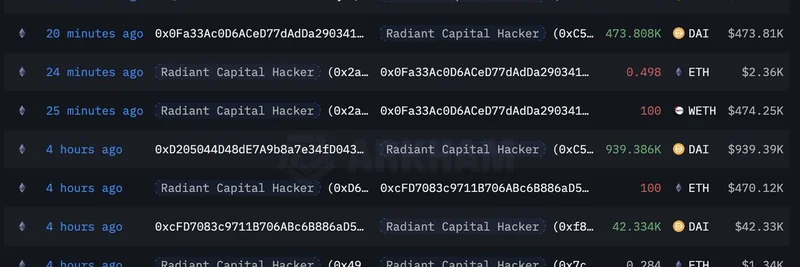In the wild world of crypto, where fortunes flip faster than a meme coin pump, the story of the Radiant Capital hacker stands out. This cyber thief didn't just grab and run—they're playing the market like a pro, turning ill-gotten gains into even bigger stacks. Thanks to a recent tweet from on-chain sleuths at Lookonchain, we've got the latest scoop on how this hacker is swinging trades on Ethereum (ETH) to boost their bounty.
What Happened in the Radiant Capital Hack?
Radiant Capital is a decentralized finance (DeFi) lending protocol that lets users borrow and lend crypto across blockchains like Ethereum, Arbitrum, and Binance Smart Chain. Back in October 2024, it suffered a massive exploit, losing around $50 million in user funds. Security experts, including firms like Halborn and OneKey, pinned the blame on North Korean hackers. They used a sneaky tactic: sending malware-laced PDFs to engineers, which gave them access to private keys and control over smart contracts.
The attackers staged malicious contracts across multiple chains and executed the heist on October 16, 2024. This wasn't Radiant's first rodeo either—in January 2024, they lost $4.5 million in a separate flash loan attack. DeFi hacks like this highlight the risks in the space, where code vulnerabilities can lead to huge losses. For more details on the technical breakdown, check out Halborn's analysis.
The Hacker's Profitable Trading Moves
Fast forward to August 2025, and the hacker isn't sitting idle. According to Lookonchain, a platform that tracks "smart money" on the blockchain, the perpetrator has been actively trading ETH with the stolen funds. Three days before the tweet, they bought 4,913 ETH worth $20.47 million at an average price of $4,168 per ETH. Then, over the next five hours, they sold 4,131 ETH for $19.52 million at $4,726 each, pocketing a cool $2.76 million profit from that swing trade alone.
This isn't their first dip-buying spree. An earlier post quoted in the thread shows them snapping up 2,109.54 ETH for 8.64 million DAI (a stablecoin pegged to the US dollar) at $4,096 per ETH, just an hour before that update. Swing trading, for the uninitiated, means holding assets for short periods—days or weeks—to capitalize on price swings, unlike long-term holding or day trading.
Overall, the hacker's original $49.5 million stash has ballooned to over $105 million—a 114% gain. Part of this growth comes from ETH's price rally, but their active trading has supercharged it. Web3 security firms note that the value of the stolen assets has doubled thanks to these moves and market surges.
Implications for the Crypto Ecosystem
Stories like this remind us why security is paramount in DeFi and blockchain. While meme tokens often grab headlines for their viral pumps, underlying infrastructure like lending protocols is where the big money—and big risks—lie. Hackers turning profits on stolen funds could inspire copycats, but it also spurs better defenses, like multi-signature wallets and rigorous code audits.
For blockchain practitioners, this is a lesson in on-chain transparency. Tools like Lookonchain make it possible to track these wallets in real-time, potentially aiding recovery efforts. Radiant Capital has been updating on their incident response—see their Medium post for official statements.
If you're into meme tokens, keep an eye on how such hacks ripple through the market. Volatility from ETH trades can affect altcoins and memes alike, creating opportunities or pitfalls. Stay vigilant, do your own research, and remember: in crypto, not all gains are legit.


